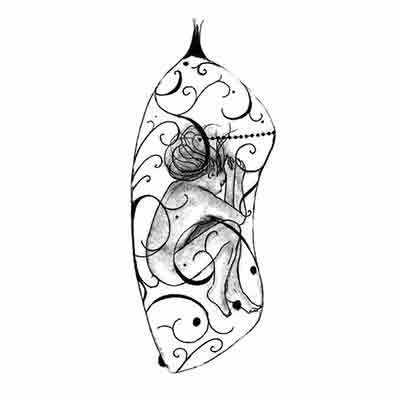The Process
WHAT IS LAMPWORKING?
Lampworking is the process of melting glass in the flame of a torch. It is not blowing glass, because the only blowing that is going on is the occasional puff to quick chill the skin of a molten piece of glass. Instead, the lampworking, or flameworker, uses tools made of flame friendly materials like graphite, or steel, or tungsten to poke and prod and cajole the glass into the concept they have. I actually learned how to torch in order to create the concept for my chrysalis bead, which was burning inside me, insisting on being created. I worked at a stained glass studio at the time and was able to methodically gather some skills.
PLAYS WITH FIRE
I personally am a bead maker. I always like to say I make my work from the inside out, which is completely accurate. The glass I use, a soda-lime made in Murano or America, melts at around 3000 degrees F. In spite of this extreme temperature, I am still able to hold the opposite side of the glass rod with bare hands, since glass is a terrible heat conductor. It is necessary to wear protective eye gear to see past the glaring flare of the flame.
- One starts a bead with a steel mandrel that has been covered in a bead release material. Therefore the beginning is the hole.
- The next step is to heat up a wand of colored glass, a glass rod, bringing it up to a molten form. It can get tricky working with molten glass. One interesting example is that oranges and reds turn black when hot. Everytime I make an almost-born bead, which is black and orangey glass, I have to work blind, unable to see the detailing as I melt it in. Fun!
- I really enjoy adding surface decoration to my beads. It adds great texture, looks cool, and is intense enough that I tend to hold my breath during the diciest moments. The extra glass is added using something called a stringer, which is simply glass that has been melted and stretched very thin. The stringer can melt the right or wrong way in less than an instant, but the surprises that come up are why glass has such an organic and fluid feel to them.
It is also why most my beads inevitably are one of a kind. - Other ways I embellish the beads are with pure gold, pure silver, special glass that is laden with metal oxides to create otherworldly effects, and just plain poking and prodding with my myriad tools.

- Once a bead has been made in the flame, it needs to be slowly and carefully brought down to room temperature-annealed. Many times my rods will explode at the tip when introduced to the flame from the heat shock. (adds nicely to the colorful mess on my bench) Well, a bead could crack or even explode on the way down as well if not dealt with properly. The bead is put into a kiln and I am not able to take a look at it until usually the next day.
- In order to suspend the bead from a piece of jewelry, I have begun to learn silver soldering. One could easily argue that I only learned how to solder in order to have another torch. Weeeellllll....nah. I love the results as well and was ready to upgrade from my wirework bails I did for years. Besides, the flame is tiny. It's smaller than a lighter's flame.
- All of these steps happen inside my home. I have a spare bedroom turned into a studio and all kinds of strange-to-the-neighbours hoses coming out the window. Right outside that same window is a wonderful overgrown mass of milkweed that have successfully hosted many a chrysalis for me to study. Even further are flowers upon flowers to inspire more beads and behind me, in the house, are my twin boys who need their own nature walks and adventures.
